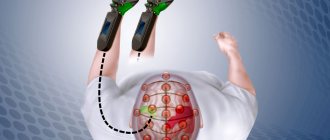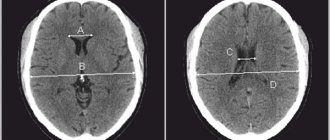Sweating and chills, cold extremities, shortness of breath, interruptions in heart rate, drowsiness, anxiety, digestive disorders - the manifestations of vegetative-vascular dystonia are numerous and varied. And all because VSD is a complex disease that affects almost all organs and systems of the body.
Our autonomic nervous system is part of the peripheral nervous system and is responsible for unconscious body functions (breathing, heartbeat, blood flow, thermoregulation, metabolism, etc.). The sympathetic branch of the autonomic system regulates the body's reactions to mental and physical stress during wakefulness, while the parasympathetic branch controls body functions and ensures restoration of strength at night.
A pathological condition of the autonomic nervous system in which this coordination of the sympathetic and parasympathetic departments is disrupted is called dystonia. Organs and systems no longer receive the required amount of oxygen, which is why various functional failures occur in them and inadequate reactions to external and internal factors occur.
It is interesting that in the West the diagnosis of “vegetative-vascular dystonia” is not made. European and American doctors call this disease “somatoform dysfunction of the autonomic nervous system.” But no matter what this set of symptoms is called - vasomotor dysfunction, angioneurosis, psycho-vegetative neurosis - it is widespread throughout the world and is observed in 80% of people.
The first manifestations of the disease can occur in childhood or adolescence, and a person encounters the most pronounced disorders in working age (20-40 years). In women, autonomic dysfunction is detected three times more often than in men.
1
Diagnosis of vegetative-vascular dystonia
2 Consultation with a neurologist
3 Consultation with a neurologist
Causes of sweating during VSD
This condition is caused by a disruption in the functioning of important parts of the nervous system that ensure the functionality of internal organs.
The autonomic nervous system (ANS) performs the following functions:
- sympathetic, speeding up the heart rate and constricting blood vessels;
- parasympathetic, in which contractions of the heart muscle become less frequent and the blood vessels dilate.
Signs of dysfunction of the ANS.
If we consider the role of the vegetative departments in more detail, we can see that they:
- “Responsible” for the body’s reaction to environmental changes and its rapid adaptation to new conditions - for example, to psycho-emotional stress or a sharp change in climate zone.
- Maintain the internal environment of the body at a normal, stable level. This refers to such parameters as body temperature, respiratory and heart rate, and metabolic rate.
Dystonia disrupts the balance of parts of the ANS, which correspondingly affects the functioning of internal organs.
Signs of VSD.
Now, finally, about how hyperhidrosis and VSD are interconnected. The following conditions are considered to be the causes of dystonia:
- neuroses and emotional stress;
- pregnancy, childbirth, breastfeeding;
- bad habits (alcohol consumption and smoking);
- physical overload;
- chronic pathologies, including infectious ones;
- endocrine disorders.
This inevitably affects the functioning of the heart and other organs, and also causes excessive sweating.
In addition, excessive sweating during VSD is also due to its symptoms:
- rapid breathing;
- increased heart rate;
- dizziness and loss of spatial orientation;
- sleep disturbance;
- increased anxiety, turning into panic fear;
- a decrease in general tone, which causes a feeling of weakness and malaise,
- increased fatigue;
- frequent migraines.
Constant body moisture creates many inconveniences, and in itself is stress, which contributes to profuse sweating. Thus, a vicious circle arises.
Symptoms
The autonomic nervous system performs very important functions: it maintains conditions for normal functioning of the body (body temperature, heart rate, blood pressure, etc.), and “corrects” the functioning of the heart, vascular tone and other parameters when necessary. For example, it stimulates the secretion of sweat in hot weather to cool the body.
Vegetovascular dystonia is a condition in which almost all systems and organs are involved. This explains why the symptoms of VSD are so varied. But all manifestations of this condition can be divided into several categories:
- Respiratory (breathing). The patient complains of rapid breathing, not associated with physical or emotional stress, a feeling of shortness of breath - the inability to take a deep breath. Episodes of excitement, fear, and anxiety can cause severe shortness of breath and a feeling of lack of oxygen.
- Cardiac (heart). In this case, VSD manifests itself as rapid heartbeat, irregular heart rhythm (a feeling that the heart is stopping in the chest, after which it begins to beat very quickly), pain and a feeling of tightness in the chest.
- Thermoregulatory. The main complaints are an unreasonable increase in body temperature, not associated with ARVI or other diseases, or a decrease in temperature.
- Dysdynamic. Such manifestations of VSD consist of circulatory disorders. This may be a slowdown in blood circulation in tissues and/or negative changes in blood pressure - an increase or decrease in blood pressure.
- Psychoneurological. This category of symptoms includes weather dependence, sleep disturbances (nighttime insomnia combined with daytime sleepiness), mood swings, apathy, irritability, unexplained anxiety attacks, and fatigue.
- Gastrointestinal. Against the background of VSD, problems with the digestive system often develop: constipation, diarrhea, or alternation of these conditions; heaviness in the stomach, heartburn, belching, flatulence.
- Sexual. Decreased libido, lack of sexual arousal, or inability to achieve orgasm while remaining aroused.
The listed symptoms can be combined in various combinations, and the predominance of certain manifestations of VSD depends on the type of this disorder.
Types of hyperhidrosis
Excessive sweating is classified into:
- Local (limited).
- Generalized.
If in the first case, hyperhidrosis affects individual parts of the body, when, for example, the palms or only the face sweat, then the second type is total in nature - the torso, limbs and head become completely wet.
Excessive sweating of the hands, feet and armpits with VSD can be:
- Primary, when it is caused by physiological reasons, for example, changes in hormonal levels during puberty.
- Secondary. In this case, excessive sweating is a consequence of health problems.
Hyperhidrosis with VSD indicates a severe course of the pathology and the need for urgent treatment. Increased body humidity in such cases manifests itself in a generalized manner and leads to constant discomfort.
Many people do not see the symptoms of dystonia as manifestations of the disease, so they do not rush to see a doctor. They try to restore health using their own methods and eliminate sweating with deodorants. This leads to the development of pathology, and hyperhidrosis becomes a constant companion.
Night sweats as a side effect of medications
For some medications, night sweats may be a side effect. If you have recently started taking a new medication and then experience increased night sweats, you should consult the doctor who prescribed the drug.
Medicines that most often cause these side effects: antidepressants, psychiatric medications, painkillers containing acetylsalicylic acid, diabetes medications, thyroid hormone medications.
Night sweats as a side effect of medications
In order for the medicine to bring maximum health benefits, you should definitely consult with your doctor before using it, and also discuss with him any changes in your health while taking the medicine.
Night sweats
Proper sleep conditions to prevent night sweats and more.
It is a signal of trouble in the body. Regular and severe sweating at night is a reason to consult a doctor, even if you seem to be feeling fine. Symptoms of VSD can develop gradually, and at first they practically do not appear.
Profuse night sweats can be perceived as a natural reaction of the body when, for example, a person takes antiviral and antibacterial drugs, as well as antipyretics.
Regular release of large amounts of sweat at night, which cannot be explained, must be regarded as a sign of the development of generalized hyperhidrosis.
With VSD, it is secondary in nature and can indicate that the person:
- is sick with tuberculosis or cancer pathologies;
- suffers from dysfunction of endocrine organs and/or other health disorders.
Hormonal disorders
Night sweats in women are often associated with hormonal fluctuations during menopause or perimenopause. Research shows that more than 80% of women experience hot flashes during this time, which causes increased sweating at night. However, hormonal imbalances can also occur in other cases - before menstruation, puberty or pregnancy.
Night hot flashes and hormonal imbalances
Bad habits such as smoking, drinking alcohol or high fat intake also stimulate the sweat glands. Fluctuating hormones can affect not only your sleep at night, but also your emotional and physical well-being, causing fatigue, low mood and often weight gain.
If any of the symptoms appear, you should contact an endocrinologist or gynecologist, who will recommend the most appropriate treatment.
Methods to reduce excessive sweating
Before treating hyperhidrosis, it is important to find out the origins of the phenomenon. When it is one of the symptoms of ill health, treatment should be based on eliminating the root cause. Otherwise, it is impossible to get rid of hyperhidrosis. The use of external agents will give a short-term effect, and the condition will worsen.
In other words, when excessive sweating is one of the signs of VSD, it is important to find out the nature of the dystonia itself and begin treatment. Correct therapy is possible only under the supervision of a doctor. He will conduct an examination, make a diagnosis and prescribe a set of medical measures.
Normalization of lifestyle
To prevent sweating due to stress, just follow simple rules.
The correct order of life plays an important role in eliminating the symptoms of VSD, including hyperhidrosis:
To reduce the amount of sweat secretion, it is important not only to consume healthy foods with sufficient vitamins and minerals. It is recommended to minimize canned, salted and smoked foods. You should not overuse meat, especially fatty varieties.
Drug treatment
Complex therapy for VSD includes taking medications that relieve symptoms, including hyperhidrosis. For this purpose, the following may be prescribed:
From the first days of their use, results will become noticeable, and excess sweating will go away.
Psychotherapy
Many doctors believe that the fight against hyperhidrosis, as a symptom of VSD, should begin with a visit to a psychotherapist. This is explained by the fact that one of the reasons for high body humidity is the excited state of the central nervous system.
Using an individual approach, the psychotherapist will tell you how best to overcome stress and cope with anxiety and prescribe appropriate medications. The patient will learn to “control himself”, stop being nervous, and therefore stop sweating a lot.
Massage
A course of massage therapy can be a simple but very effective solution in combating the symptoms of VSD. A month of manual procedures can significantly increase stress resistance, remove signs of dystonia, and normalize sweating.
Maintaining personal hygiene rules
For people suffering from hyperhidrosis, proper body care is of particular importance. This means that hygiene procedures must be regular and complete. During the hot season, it is recommended to shower several times a day. This will allow you to put your body in order and also get rid of the unpleasant odor of sweat.
It is important to dress correctly so as not to create a “greenhouse effect”. This means things should:
- correspond to the season and weather;
- be made from natural fabrics.
Following these simple rules will slightly reduce the intensity of sweating and minimize the discomfort from hyperhidrosis.
Vegetative-vascular dystonia is considered a very common pathology. Its debut can occur in childhood or adolescence. In adults 20-40 years old, symptoms of VSD, including profuse sweating, are already pronounced. Women are most susceptible to dystonia. They suffer from this disease three times more often than men.
It is hardly possible to be 100% insured against vegetative pathology and its symptoms - the dynamics and conditions of modern life make this impossible. But if you treat your own body with care and respond to its “signals” in a timely manner, you can minimize the risk of developing dystonia, and therefore increased sweating.









